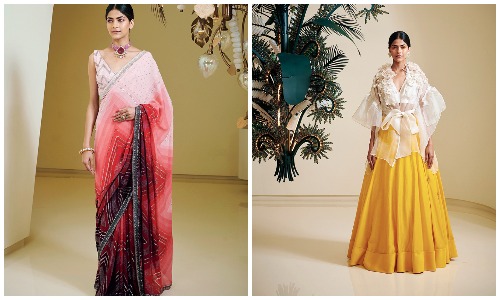Saying that Varun Bahl’s latest collection comprises intricate handiwork representative of south Asia’s grand heritage of crafts, giving a rich texture to silhouettes such as capes, waistcoats, lehngas and shararas crafted on exquisite pure silk organza, satin, georgette, chiffon and tulle, is barely touching the tip of the iceberg. A sorbet of colours that mix pastels and richer hues ensure the wearability of the designs for spring/summer. The capes and waistcoats infuse the couture line with chicness and spunk. The couturier (inset) continues to not weigh down the fabrics with too much embellishment and presents his designs as a “modern solution for today’s customers”. Here’s A Midsummer Dream in Varun’s words:

Varun Bahl
The collection looks like a dream in pastels with some great deeper hues too. How did you conceive the collection to strike that balance?
It comes to me very naturally; I’ve always believed that textiles and crafts have to be innovated with and presented as modern design solutions for today’s customers. The rich colour palette and the traditional motifs come together to tell a story that’s woven using the timeless methods and techniques of south Asian patrimony.
What is the inspiration behind this collection?
A blend of the past and the present, this collection is inspired by the grandeur of south Asian heritage beautifully amalgamated with the subtle hues of today.
Lots of floral and intricate handwork on the ensembles are striking. Take us through the technicalities of the design process in terms of the silhouettes and the craft techniques used.
With the new couture collection, I have tried to bring to life a variety of silhouettes like capes, waistcoats, lehngas, saris, sharara sets in fabrics like pure silk organza, satin, georgette, chiffon and tulle. Capes with surfacing techniques like 3D floral embroidery and ruffles and lehngas, sharara sets and waistcoats highlighted with sequin detailing, cut-dana, Swarovski and resham thread work.
From the floral motifs to the prepense meandering of lines — the pattern, prints and embellishments speak exceedingly about the intricacy of work that each garment showcases.

Considering that the collection highlights Indianwear, have you witnessed any change in India’s fashion appetite for the same since celebrations have been forced to become more mellow now?
The consumer has definitely moved away from the heavy bridal lehngas to capes, shararas and modern silhouettes. They don’t shy away from repeating an outfit. However, an Indian bride will always be a bride. The mindset has not changed there much. Most brides still go for a heavy bridal lehnga for their big day.
With the pandemic ravaging the country once again and all industries taking a hit, how do you see it affecting the fashion industry and what is the way ahead?
Living through a pandemic, people have started re-thinking their choices and preferences, and are likely to become more conscious about what they buy, especially when they know that their spending has a direct link to the local economy and how their spending choices can shape lives. Going forward, everyone must use these learnings to consciously support local products and industries as a way to re-energise them, whether it’s food, fashion, entertainment or even travel.
In terms of fashion, especially Indian heritage wear, evolving with the times, how do you see it happen and how would you keep up with it?
It’s the realisation of the kind of designer I would like to be: more focused on celebrating India’s legendary crafts and ensuring employment for my family of artisans. I personally have restructured the way I work and strongly feel that it will allow me to emerge stronger both in terms of my creative abilities and the growth of my business and brand.
Pictures courtesy: The designer











